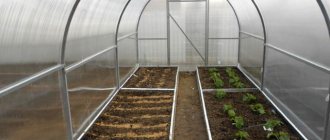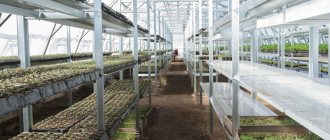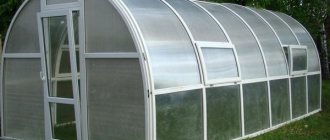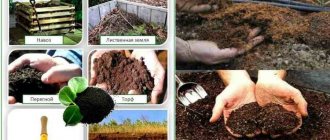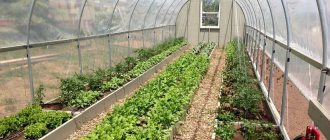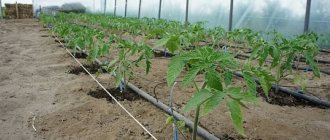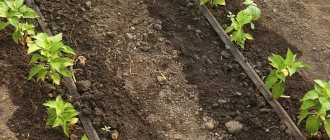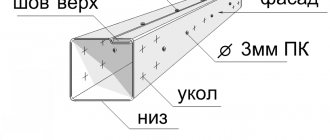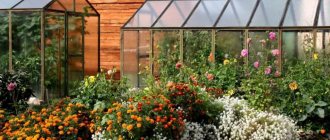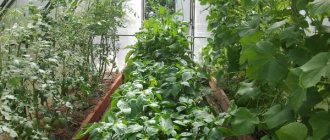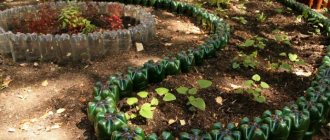The correct internal arrangement of a polycarbonate greenhouse should solve several main problems. Firstly, it is the creation of an ideal microclimate for plants, including the optimal combination of humidity, temperature, sunlight and ventilation. Secondly, organizing a convenient place to work. Thirdly, maximum use of all useful internal space of the structure.
How to arrange a polycarbonate greenhouse inside, determine the optimal number of beds and paths, and use shelves and racks correctly? You will find answers to these questions in this article.
Invalid Displayed Gallery
Features of greenhouse arrangement
A greenhouse is a space that is intended for growing plants, as well as for preparing crops for planting in open ground. It is important to properly organize the greenhouse inside, taking into account its size and the needs of the gardener. A certain temperature and humidity level must be maintained inside the room. If you follow the basic recommendations, tips and tricks during the work, then it is possible to grow several types of plants in one greenhouse, using the available space as competently as possible.
Since greenhouses vary not only in size, but also in purpose, the internal arrangement will also differ significantly. For example, in some it is necessary to create beds, in others it is necessary to arrange shelving. If necessary, you can add additional equipment, which will greatly facilitate the process of growing crops.
Advice! If necessary, you can see the interior arrangement of a polycarbonate greenhouse in the photo.
Types of structures
A favorable microclimate is created inside the greenhouse, which protects plants from the vagaries of nature. Crops are not afraid of frost, cold rain and gusty winds. Properly equipped facilities allow you to grow vegetables, fruits and flowers in winter. In summer, the structure will protect from burning out in the heat and from hail.
The type of greenhouse depends on the type and requirements of the plants to be grown. Models are divided into 3 groups:
- Homemade. Compact greenhouses are assembled from window frames or film and are used only in the warm season. No more than 2 crops will fit inside.
- Polycarbonate. The polymer material transmits ultraviolet light well, but is not as fragile as glass. The sheets are easy to mount on the frame. To use the greenhouse in cold weather, it is necessary to provide a heating system.
- Professional. The model for year-round use has thermal insulation, heating and lighting. Ventilation is required.
Internal arrangement Source semena174.ru
Inside the greenhouse, the temperature necessary for the development of certain types of plants is maintained. Often, vegetables are grown in polycarbonate types from spring to autumn, then the cacti are given a “cold winter” within 7-5 C. If you increase the humidity level, the structure will help cultivate tropical flowers, shrubs and low exotic trees.
Greenhouse for plants Source homify.ru
Construction of beds and paths
Before you begin the interior layout of the greenhouse, it is recommended to consider some important rules:
- First, decide what crop will be grown in a greenhouse: some types of plants are best grown in beds, while for others it is best to use racks;
- many gardeners advise initially spreading plastic film in the greenhouse, then covering it with soil; then, after watering the plants, the water will not go into the ground;
- in order to prevent the soil from the beds from crumbling into paths during the care process, it is worth fencing them; for convenience, you can lay out the paths with bricks, tiles or boards;
- All building materials used as fencing must be moisture-resistant and treated with special protective compounds that prevent the appearance of fungus and mold.
It is recommended to carry out all arrangement work before the start of the summer season.
Location
The inside of the greenhouse should not only look beautiful, but also be as comfortable as possible. In addition, it is worth focusing on the cardinal directions, which significantly affects the level of yield. The optimal solution is to arrange the beds inside the greenhouse along an east-west line, as a result of which the crop will receive a sufficient amount of sunlight throughout the day.
It is important not only to look at the design of the greenhouse inside in the photo, but also to understand how wide the beds should be and how many of them should be made:
- beds whose width varies from 70 to 90 cm are considered optimal; under such conditions, seedlings will receive the required amount of light and moisture;
- The width of the path is 40 cm, making it convenient to move around the greenhouse.
When arranging a polycarbonate greenhouse 3 by 6 m inside, you can make 3 beds 70 cm wide and 2 paths 45 cm wide.
Advice! If the greenhouse is narrow, two meters high, then it is recommended to make 2 beds of 75 cm each and one path in the middle.
Borders for beds
In the process of arranging beds inside a polycarbonate greenhouse, everything must be done in such a way that the soil does not crumble after irrigation. Sides are used for these purposes:
- if you want to choose the simplest method, you can bury boards in the ground; the wood is pre-treated with special protective substances to prevent the appearance of fungus and mold;
- you can use facing or ordinary bricks to decorate the beds inside the greenhouse; it is important to understand that such a design has an attractive appearance, but it also takes up a lot of space;
- budget option - using polycarbonate sheets, which are pre-cut into strips of the required height;
- If necessary, asbestos-cement slate can be used in the case.
The deeper the sides are in the ground, the better this will affect the crop being grown.
Attention! The height of the side can reach 4 cm - this will be quite enough so that during the process of caring for the crop inside the greenhouses, the soil does not crumble from the beds.
Path covering
You can decorate the inside of the greenhouse not only with sides and a beautiful arrangement of beds, but also with paths. If necessary, the paths inside the greenhouse can be covered with gravel or crushed stone, and then the following types of materials can be laid on top:
- paving slabs;
- brick;
- flat slatted stones;
- boards (when using wood, it must be treated with protective compounds, which will significantly extend the service life of the material).
The most durable option is considered to be a concrete screed, which can be used to pour paths between the beds inside the greenhouse. In addition, there will be much less weeds.
Separation of crops in a greenhouse
Every gardener, having a greenhouse at his dacha, wants to use it to the maximum. Even if you plan to plant in a 3m by 6m greenhouse, the planning must be done correctly. Separation of crops is necessary, since not all plants can be adjacent to each other. For example, tomatoes and bell peppers prefer sparse irrigation and fresh air, while cucumbers require regular watering and high humidity levels.
In order to be able to grow several different crops simultaneously in one greenhouse, it is necessary to create favorable conditions for them, namely, to divide the space using partitions for these purposes. Curtains made of polyethylene film or polycarbonate sheets are ideal as partitions. To understand exactly how the interior decoration of the greenhouse will look, you can look at the photo.
Requirements for mini-greenhouses
Home greenhouses must meet the following requirements:
- maintaining the microclimate inside the structure necessary for plants. Only in this case can you get a rich harvest;
- ease of use. The structure should be easy to open so that you can access the plants at any time, perform irrigation, etc. All plantings must be visible when viewed from any angle;
- aesthetics. The design of the structure must fit into the interior of the room in which it is installed;
- strength, reliability. The device must withstand repeated opening and closing;
- transparent walls. They provide light access to plants.
Transparent walls in the mini-greenhouse provide light access to the plants
How to equip a greenhouse
Today, there are a large number of options, thanks to which it is possible to intelligently think through the layout inside 3x4 m, 3x6 m greenhouses. If the available space is used as competently and correctly as possible, then the process of caring for the crop can be significantly simplified. In order to increase the level of productivity, it is worth taking care of heating, the presence of shelving, heating, and an automated irrigation system. If necessary, you can equip the greenhouse inside with your own hands, without the help of specialists.
Drip irrigation system
It is impossible to imagine setting up a home greenhouse without a drip irrigation system, which greatly facilitates the process of watering the crop. It is also recommended to take care of this system at the beginning of designing a greenhouse in order to avoid unforeseen issues and problems in the future. If you do all the work correctly, then caring for the plants will be very easy, and it will take a minimum amount of time.
Lighting and heating
Additional lighting inside the greenhouse is required when daylight hours become short and the seedlings do not receive the amount of sunlight necessary for growth and development. When choosing lighting, it is recommended to give preference to multispectrum lamps that have blue ultraviolet radiation. In a specialized store you can purchase LED, fluorescent and gas-discharge lighting devices.
Since the main thing in any greenhouse is heat, in addition to solar heat, additional heating will not hurt. Many experts recommend using several types of heating to arrange the inside of a greenhouse:
- gas-burners;
- stove for using wood, peat, coal;
- electric convector;
- water heating system;
- solar collector;
- biofuel.
It is important to understand that you need not only to obtain heat, but also to retain it inside the greenhouse. That is why this issue should be given due attention at the design stage of a greenhouse made of polycarbonate sheets. First, it is recommended to first look at the photo on how to make a greenhouse inside as competently as possible.
Ventilation
It is important not only to look at the photo on how to properly decorate the inside of the greenhouse, but also to equip it with everything necessary. Thus, a ventilation system together with heating is required when it is planned to grow crops quite early or it is necessary to significantly increase the yield level.
A ventilation system is required in the following cases:
- so that the heat is distributed evenly inside the greenhouse;
- to ensure cross ventilation;
- for access of air flows through the roof.
In most cases, artificial ventilation is used in conjunction with stove heating. For these purposes, large fans are used, which are placed in close proximity to the heat source. This approach allows heat to be dispersed throughout the entire greenhouse.
Basement preparation
Before you begin outfitting your greenhouse, make sure your basement meets the following requirements.
- During the year the temperature does not fall below 0°C.
- The basement is sealed and is not flooded by groundwater and melted snow.
- There is no fungus, rats or other pests in the basement of the house.
If the temperature drops too low in winter, you need to insulate the walls and floor. To do this, you can use any available insulating materials. In addition, regularly warm up the room using space heaters or other heating devices.
In a basement adapted for growing vegetables, there should be no drafts, so all cracks should be sealed.
It is impossible to successfully grow vegetables in a leaky basement. Before building a greenhouse, make sure that you have sealed all holes and set up the ventilation system.
If you find insects, rats or moles, use any method to eliminate them. For the basement, it is recommended to use smoke bombs, dusts or traps with poisoned baits. When all pests are destroyed, carry out general cleaning and minor repairs. Wash the floor, wipe down and paint the walls. To prevent insects, you can use special paints that contain insecticides.
Arrangement of shelving
Using shelving inside the greenhouse allows you to make maximum use of all available space. In addition, it becomes possible to grow both tall and short types of crops.
If you plan to grow seedlings on racks, then you should take into account the following advantages:
- the space inside the greenhouse can be used to the maximum;
- caring for seedlings is much easier and more convenient;
- if necessary, seedlings can be placed depending on the level of thermophilicity of a particular crop;
- in the case when the racks are additionally equipped with wheels, they become mobile, thanks to which the structures can be rearranged and turned to sunlight on any side.
When arranging the shelving, it is recommended to take care of the concrete base first. This is due to the fact that the weight of the rack along with the containers for seedlings, which are filled with soil, will be quite large, as a result of which the soil under the structure will begin to sag.
Important! For clarity, you can see what the arrangement of shelving inside the greenhouse looks like in the photo.
Shelving material
The arrangement inside a 3 m by 8 m greenhouse must be done correctly so that caring for the crop in the future does not cause difficulties. Any type of building material can be used to make shelving. In addition, you can independently weld a durable metal frame at home or use timber.
For horizontal shelves, boards are used that are pre-treated with special protective compounds that prevent the appearance of mold and mildew during operation. It is recommended to determine the distance between shelves and their number based on the maximum growth of the crop. Thus, if we consider a greenhouse whose height is 2 m, then a rack of 6 shelves can be placed inside.
Installation of shelving
The improvement of the greenhouse inside, the photos are presented below, should come first. Since the most important thing is to use the available space correctly, some gardeners, when setting up greenhouses, install shelving above the beds inside. It is precisely because of space saving that multi-tiered and suspended structures appear. Such structures can be the same size or taper from bottom to top.
Construction of a quarantine zone
When arranging a greenhouse inside with a width of three meters or more, you can take care of the presence of a quarantine zone. For these purposes, aquariums with a volume of 100 liters or more are used, into which seedlings susceptible to diseases are placed. Such a container should definitely be placed in the darkest corner so that direct sunlight does not harm the leaves of the seedlings. If you isolate infected plants in a timely manner, you can prevent mass infection of all crops.
More light
Do plants in a greenhouse need additional light? It is definitely needed, but only if you are going to grow (grow) seedlings in a greenhouse. With short daylight hours, which occurs at the beginning of the growing season, additional lighting is an urgent need, without which the sprouts will not be able to develop into full-fledged plants.
The second case when additional light may be needed is additional illumination of light-loving plants to obtain maximum yield and full ripening of fruits.
Greenhouse lighting
How to choose lighting equipment for a greenhouse? To do this, you need to compare different lighting methods in order to settle on the most acceptable one.
Table. Types of lighting lamps and their characteristics.
| Name | Description of action |
| Incandescent lamps | May differ in the type of radiation. They cannot be used for all plants. For example, they are contraindicated for cucumbers and tomatoes - they contribute to cell deformation and cause burns on the leaves when used for a long time. Mainly used for growing early greens. |
| Mercury vapor lamps | These high-incandescent light sources are also used in greenhouses, but they have a significant drawback - too much radiation. UV rays are not suitable for the near spectrum and can harm plants rather than help. In addition, the lamps become very hot, which also causes burns. |
| Fluorescent lamps | Most often used. They have virtually no flaws, and the price is low. In addition, the lamps are economical and durable. The disadvantages are low heat transfer rates, but the lamps cope with the task of lighting. |
| Sodium lamps | These high-pressure lamps are famous for their most economical efficiency and the highest quality of light output. They create a monochromatic light field that has a beneficial effect on plants in all phases of development. The light emanating from sodium lamps is exactly what the green inhabitants of greenhouses need for a full and comfortable life. |
| Metal halide lamps | Without reservations - an ideal option. The cost is low, durability is high. All luminescence indicators create an absolutely natural “natural” lighting background. |
| LED bulbs | This is rather from the category of expensive whims. LEDs are installed in winter gardens and tropical greenhouses, but rather for beauty, since there is no single competent opinion among farmers about the advisability of using LEDs for the benefit of plants. |
Arrangement of the vestibule
Another important point that can be implemented in the process of planning a greenhouse at a dacha 3 m by 8 m is the vestibule. In the future, the vestibule can be used to store garden tools. It is very inconvenient to constantly carry everything you need to care for your crop from home or a barn to the greenhouse; it is much more convenient and comfortable when everything you need is at hand. To do this, it will be enough to fence off a small space at the entrance to the greenhouse where you can place shovels, rippers, fertilizers, gloves, and a hoe.
For maximum convenience, during the internal arrangement of a polycarbonate greenhouse, it is recommended to install special fasteners for fixing the cuttings of working tools, which will allow you to properly use the free space.
Practical advice
For a large greenhouse, especially a heated one, it is recommended to equip a kind of vestibule. It will serve as an obstacle to cold air entering the greenhouse, and also perform a practical function: you can store tools, equipment, fertilizers, and pest control products in it.
Greenhouses equipped with vestibules
It is recommended to set up a quarantine corner inside the greenhouse. It is a rack or part of it, hermetically sealed with a door made of glass or polycarbonate. New plants are usually placed in it to check for diseases or pests.
After 1-2 weeks, they can already be transferred to the main zone of the greenhouse. Also, pots with plants that have begun to get sick are placed in quarantine so that the infection does not spread to healthy crops.
Tags: shelf, seedlings, greenhouse
About the author: admin4ik
« Previous entry
Ideas for beautiful interior design of a greenhouse
Today, there are a large number of options for arranging the inside of a greenhouse with your own hands, as a result of which you can get confused. Before you begin arranging the space, you need to take appropriate measurements and decide what crop will be grown. Only after this can you begin installing shelving or arranging beds. In order to properly equip a 3x6 m polycarbonate greenhouse inside, it is recommended that you familiarize yourself with already implemented projects.
Subtleties of doing business
You can reduce the cost of production and increase profits by purchasing materials from the manufacturer. This can be done by concluding agreements for the supply of products. And in order to conclude an agreement, you need to register an individual entrepreneur.
Only an individual approach to each client will help you win the competition and, over time, purchase professional equipment that will allow you to establish a serious technological process.
Video on the topic: Greenhouses - Video review
Selection of questions
- Mikhail, Lipetsk — What discs should I use for cutting metal?
- Ivan, Moscow - What is the GOST for rolled sheet steel?
- Maxim, Tver - Which racks for storing rolled metal products are better?
- Vladimir, Novosibirsk — What does ultrasonic processing of metals without the use of abrasives mean?
- Valery, Moscow - How to forge a knife from a bearing with your own hands?
- Stanislav, Voronezh — What equipment is used for the production of galvanized steel air ducts?
